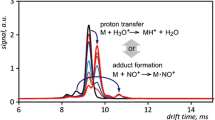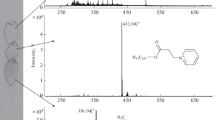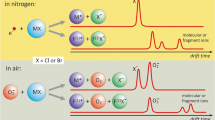Abstract
In this paper, we demonstrate that humidity is a crucial parameter for analysis of aromatic compounds of low polarity with planar differential ion mobility spectrometry. Utilization of polar modifiers which are usually applied for the improvement of separation ability of DMS based systems does not improve the separation of aromatic compounds. Moreover, the peak area of the model compounds decreases with the increase of the modifier (water vapors and 2-propanole) concentration. The influence of the polar modifiers on the DMS separation ability was proven on examples of the six aromatic compounds (BTEX, 1,2,4-trimethylbenzene (TMB), and naphthalene) and one aliphatic compound (hexane). The influence of the modifier concentration on the compensation voltage, peak area, and peak width was investigated and discussed. The strong influence of the proton affinity of analytes on the peak area in the measurements with modifiers was demonstrated. Some notable aspects of the formation of the reactant ion positive are demonstrated and discussed.





Similar content being viewed by others
References
Baciocchi R, Berardi S, Verginelli I (2010) Human health risk assessment: Models for predicting the effective exposure duration of on-site receptors exposed to contaminated groundwater. J Hazard Mater 181:226–233. doi:10.1016/j.jhazmat.2010.05.001
Shih T, Rong Y, Harmon T, Suffet M (2004) Evaluation of the impact of Fuel hydrocarbons and oxygenates on groundwater resources. Environ Sci Technol 38:42–48. doi:10.1021/es0304650
Saeed T, Al-Mutairi M (1999) Chemical composition of the water-soluble fraction of the leaded gasolines in seawater. Environ Int 25:117–129. doi:10.1016/S0160-4120(98)00093-2
Chary NS, Fernandez-Alba AR (2012) Determination of volatile organic compounds in drinking and environmental waters. Trends Anal Chem 32:60–75. doi:10.1016/j.trac.2011.08.011
Schneider BB, Covey TR, Nazarov EG (2013) DMS-MS separations with different transport gas modifiers. Int J Ion Mobil Spectrom 16:207–216. doi:10.1007/s12127-013-0130-8
Liang F, Kerpen K, Kuklya A, Telgheder U (2012) Fingerprint identification of volatile organic compounds in gasoline contaminated groundwater using gas chromatography differential ion mobility spectrometry. Int J Ion Mobil Spectrom 15:169–177. doi:10.1007/s12127-012-0101-5
Shvartsburg AA (2008) Differential ion mobility spectrometry: nonlinear ion transport and fundamentals of FAIMS. CRC Press, Boca Raton, ISBN-13: 978–1420051063
Kolakowski BM, Mester Z (2007) Review of applications of high-field asymmetric waveform ion mobility spectrometry (FAIMS) and differential mobility spectrometry (DMS). Analyst 132:842–864. doi:10.1039/b706039d
Krylov EV, Nazarov EG (2009) Electric field dependence of the ion mobility. Int J Mass Spectrom 285:149–156. doi:10.1016/j.ijms.2009.05.009
Buryakov IA, Krylov EV, Nazarov EG, Rasulev UK (1993) A new method of separation of multi-atomic ions by mobility at atmospheric pressure using a high-frequency amplitude-asymmetric strong electric field. Int J Mass Spectrom Ion Process 128:143–148. doi:10.1016/0168-1176(93)87062-W
Miller RA, Nazarov EG, Eiceman GA, King AT (2001) A MEMS radio-frequency ion mobility spectrometer for chemical vapor detection. Sensors Actuators A Phys 91:301–312. doi:10.1016/S0924-4247(01)00600-8
Levin DS, Vouros PA, Miller RA, Nazarov EG, Morris JC (2006) Characterization of gas-phase molecular interactions on differential mobility ion behavior utilizing an electrospray ionization-differential mobility-mass spectrometer system. Anal Chem 78:96–106. doi:10.1021/ac051217k
Coy SL, Krylov VE, Nazarov EG, Fornace AJ Jr, Kidd RD (2013) Int J Ion Mobil Spectrom 16:217–227. doi:10.1007/s12127-013-0135-3
Kuklya A, Uteschil F, Kerpen K, Marks R, Telgheder U (2014) Development of an electrospray-63Ni-differential ion mobility spectrometer for the analysis of aqueous samples. Talanta 120:173–180. doi:10.1016/j.talanta.2013.10.056
Eiceman GA, Krylov EV, Krylova NS, Nazarov EG, Miller RA (2004) Separation of ions from explosives in differential mobility spectrometry by vapor-modified drift gas. Anal Chem 76:4937–4944. doi:10.1021/ac035502k
Rorrer LC III, Yost RA (2011) Solvent vapor effects on planar high-field asymmetric waveform ion mobility spectrometry. Int J Mass Spectrom 300:173–181. doi:10.1016/j.ijms.2010.04.002
Schneider BB, Covey TR, Coy SL, Krylov EV, Nazarov EG (2010) Control of chemical effects in the separation process of a differential mobility mass spectrometer system. Eur J Mass Spectrom 16:57–71. doi:10.1255/ejms.1025
Purves RW, Guevremont R, Day S, Pipich CW, Matyjaszczyk MS (1998) Mass spectrometric characterization of a high-field asymmetric waveform ion mobility spectrometer. Rev Sci Instrum 69:4094–4105. doi:10.1063/1.1149255
Kolakowski BM, McCooeye MA, Mester Z (2006) Compensation voltage shifting in high-field asymmetric waveform ion mobility spectrometry-mass spectrometry. Rapid Commun Mass Spectrom 20:3319–3329. doi:10.1002/rcm.2739
Wojdyr M (2010) Fityk: a general-purpose peak fitting program. J Appl Crystallogr 43:1126–1128. doi:10.1107/S0021889810030499
Nazarov EG, Coy SL, Krylov EV, Miller RA, Eiceman GA (2006) Pressure effects in differential mobility spectrometry. Anal Chem 78:7697–7706. doi:10.1021/ac061092z
Kim SH, Betty KR, Karasek FW (1978) Mobility behavior and composition of hydrated positive reactant ions in plasma chromatography with nitrogen carrier gas. Anal Chem 50:2006–2012. doi:10.1021/ac50036a018
Mäkinen M, Sillanpää M, Viitanen A-K, Knap A, Mäkelä J, Puton J (2011) The effect of humidity on sensitivity of amine detection in ion mobility spectrometry. Talanta 84:116–121. doi:10.1016/j.talanta.2010.12.030
Mayer T, Borsdorf H (2014) Anal Chem 86:5069–5076. doi:10.1021/ac5007393
Krylova N, Krylov E, Eiceman GA, Stone JA (2003) Effect of moisture on the field dependence of mobility for gas-phase ions of organophosphorus compounds at atmospheric pressure with field asymmetric ion mobility spectrometry. J Phys Chem A 107:3648–3654. doi:10.1021/jp0221136
Warneke C, van der Veen C, Luxembourg S, de Gouw JA, Kok A (2001) Measurements of benzene and toluene in ambient air using proton-transfer-reaction mass spectrometry: calibration, humidity dependence, and field intercomparison. Int J Mass Spectrom 207:167–182. doi:10.1016/S1387-3806(01)00366-9
Schneider BB, Nazarov EG, Covey TR (2012) Peak capacity in differential mobility spectrometry: effects of transport gas and gas modifiers. Int J Ion Mobil Spectrom 15:141–150. doi:10.1007/s12127-012-0098-9
Chong S-L, Franklin JL (1972) Proton affinities of benzene, toulene, and the xylenes. J Am Chem Soc 94:6630–6635. doi:10.1021/ja00774a010
Hunter EPL, Lias SG (1998) Evaluated gas phase basicities and proton affinities of molecules: an update. J Phys Chem Ref Data 27:413–656. doi:10.1063/1.556018
Auea DH, Guidonia M, Betowski LD (2000) Ab initio calculated gas-phase basicities of polynuclear aromatic hydrocarbons. Int J Mass Spectrom 201:283–295. doi:10.1016/S1387-3806(00)00210-4
Benzene (2013) MSDS, version 5.1; Sigma-Aldrich, Oct 17
Toluene (2014) MSDS, version 5.4; Sigma-Aldrich, Jan 29
Ethylbenzene (2010) MSDS, version 10.1; Merck, Nov 04
p-Xylene (2014) MSDS, version 9.3; Merck, May 15
Zhao J, Zhang R (2004) Proton transfer reaction rate constants between hydronium ion (H3O+) and volatile organic compounds. Atmos Environ 38:2177–2185. doi:10.1016/j.atmosenv.2004.01.019
1,2,4-Trimethylbenzene, MSDS, version 5.1; Sigma-Aldrich, Jul 04, 2013
Naphthalene (2010) MSDS, RN 1; Acros, Sep 27
Hunter KC, East ALL (2002) Properties of C−C Bonds in n-Alkanes: relevance to cracking mechanisms. J Phys Chem A 106:1346–1356. doi:10.1021/jp0129030
n-Hexane (2014) MSDS, version 18.0; Merck, Apr 14
Blake RS, Patel M, Monks PS, Ellis AM, Inomata S, Tanimoto H (2008) Aldehyde and ketone discrimination and quantification using two-stage proton transfer reaction mass spectrometry. Int J Mass Spectrom 278:15–19. doi:10.1016/j.ijms.2008.07.010
2-Hexanone (2006) MSDS, version 1.0; TCI, Apr 04
Goebbert DJ, Wentold PG (2004) Water dimer proton affinity from the kinetic method: dissociation energy of the water dimer. Eur J Mass Spectrom 10:837–846. doi:10.1255/ejms.684
Water (2012) MSDS, RN 4; Acros, Jun 15
Acknowledgments
The authors thank Michell Instruments for providing an advanced dew-point hydrometer.
Author information
Authors and Affiliations
Corresponding author
Rights and permissions
About this article
Cite this article
Kuklya, A., Uteschil, F., Kerpen, K. et al. Effect of the humidity on analysis of aromatic compounds with planar differential ion mobility spectrometry. Int. J. Ion Mobil. Spec. 18, 67–75 (2015). https://doi.org/10.1007/s12127-014-0162-8
Received:
Revised:
Accepted:
Published:
Issue Date:
DOI: https://doi.org/10.1007/s12127-014-0162-8




